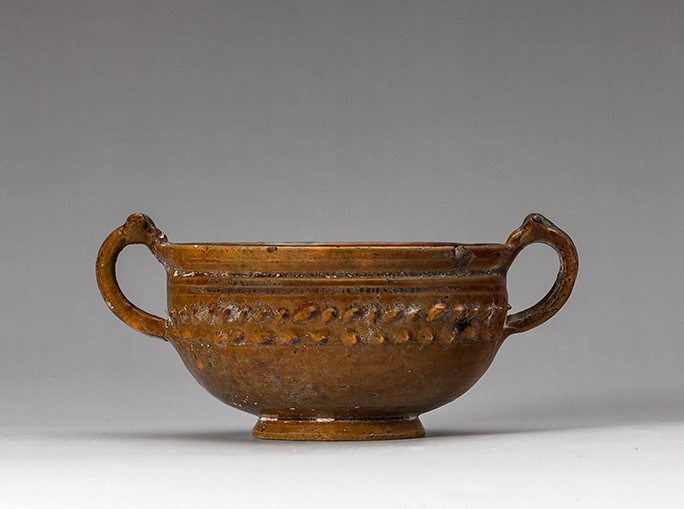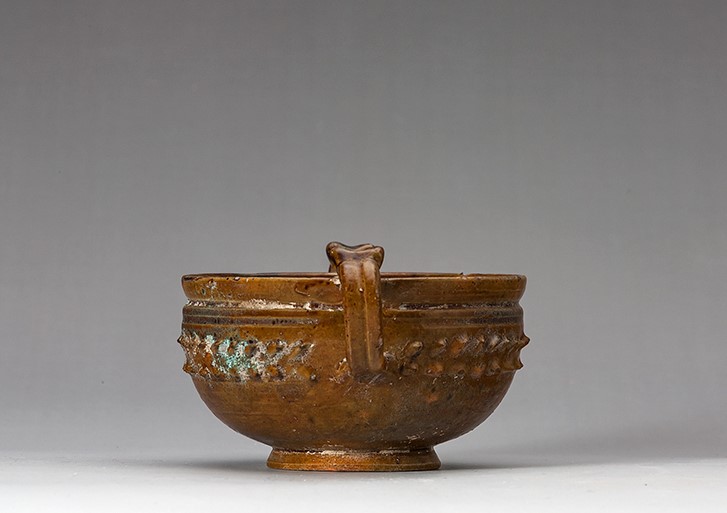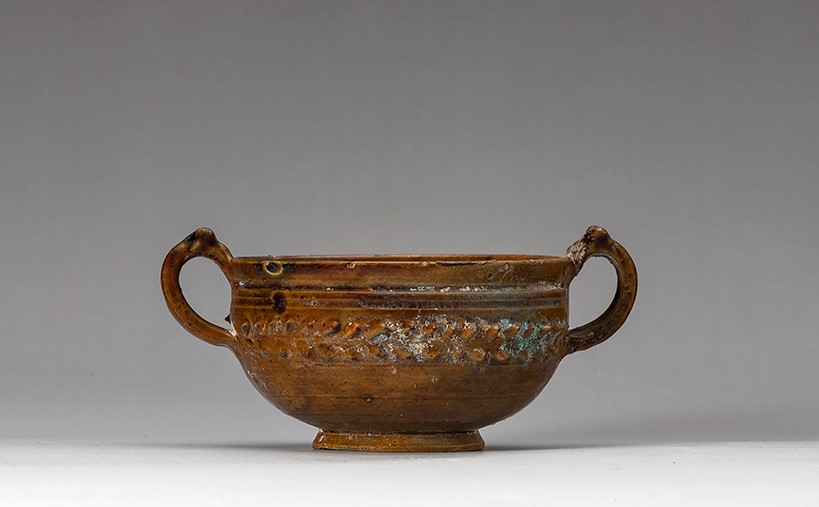Acquisition number: 1971.02
Intact but for a chip from the lip and for one handle which has been rejoined. Double handles with spurs on their shoulders; ring foot with ring mouldings on the underside of the floor. On the wall, A and B, below a broad groove, a spray in barbotine technique. The entire surface including the underside is covered in lead glaze of a mid-green colour with a yellowish tinge. The clay is invisible.
Title: Roman Lead-Glazed Kantharos - 1971.02
Acquisition number: 1971.02
Author or editor: J.R. Green
Culture or period: Roman Imperial
Date: Late 1st century BC - 1st century AD.
Material: Clay - Terracotta
Object type: Vessels - Kantharos
Dimensions: 99mm (w) × 56mm (h)
Origin region or location: Türkiye
Display case or on loan: 12
Keywords: Roman, Imperial, Republic, Lead glaze, Syrian, Russian, Roman Asia
Folio Fine Art Ltd (London), Catalogue 77 (November 1970) no. 740 (ill.); J.R. Green with B. Rawson, Catalogue of Antiquities in the Australian National University, A.N.U. (Canberra, 1981) 77.
1971.02
Roman Lead-Glazed Kantharos
Purchased. Ht (lip) 5.6cm; diam. 9.9cm.
Intact but for a chip from the lip and for one handle which has been rejoined. Double handles with spurs on their shoulders; ring foot with ring mouldings on the underside of the floor. On the wall, A and B, below a broad groove, a spray in barbotine technique. The entire surface including the underside is covered in lead glaze of a mid-green colour with a yellowish tinge. The clay is invisible.
This piece differs from all the other pottery in the collection in having a true lead-glaze. The technique was developed in North Syria whence it quickly spread to a number of centres in Asia Minor. These centres seem to have been responsible for a great proportion of the extant material in the second half of the first century BC and the first century AD, and this piece is doubtless from one of them. Lead-glazed ware was also produced in South Russia and manufacture was taken up in the West too, including Gaul and Germany, in the course of the first century AD.
By ancient standards, manufacture was a complex process. The vases had to be fired before the glaze was applied, and then re-fired. Special care also had to be taken with stacking in the kiln not only to ensure even firing but to cope with the problems of surplus glaze dripping down onto pieces lower in the kiln. F.F. Jones (see bibliography on this item) has also pointed out that lead-poisoning must have been an occupational hazard - as it was in more recent times - and all these reasons may account for the relatively short life of the ware.
Although jugs and kraters were also made in this technique (not to mention lamps and figurines), ring-handled kantharoi of this general type are by far the most common. Most are mould-made with relief decoration, but the barbotine technique appears occasionally and seems more often to have been used in South Russian workshops.
The more important treatments of lead-glazed ware are F.F. Jones, “Rhosica Vasa”, American Journal of Archaeology 49, 1945, 45-51; F. F. Jones in H. Goldman (ed.), Excavations at Gözlü Kule, Tarsus I (Princeton 1950) 191ff.; D. Pinkwart in Antiken aus Rheinischem Privatbesitz (Bonn 1973) 83 and pl. 55ff.; H. Gabelmann, “Zur hellenistisch-römischen Bleiglasurkeramik in Kleinasien”, Jahrbuch des Deutschen Archäologischen Instituts 89, 1974, 260-307; and A. Hochuli-Gysel, Kleinasiatische glasierte Reliefkeramik (Berne 1977), but see the reservations expressed by Hayes, Handbook 100 and now the important article by P. Roberts, “‘Singing all summer and dancing all winter’: a Group of Lead-Glazed Ware Vessels in the British Museum”, in: N. Crummy (ed.), Image, Craft and the Classical World. Essays in Honour of Donald Bailey and Catherine Johns (Monographies instrumentum, 29, Montagnac 2005) 23-38. He provides a good typology of shapes and suggests a production date of ca 20 bc – ad 20. Good too is K. Greene, “Late Hellenistic and Early Roman Invention and Innovation: The Case of Lead-GlazedPottery”, American Journal of Archaeology 111, 2007, 653-671.
See further the review article by M.S. Tite et al., “Lead Glazes in Antiquity: Methods of Production and Reasons for Use”, Archaeometry 40, 1998, 241-260.
Folio Fine Art Ltd (London), Catalogue 77 (November 1970) no. 740 (ill.); J.R. Green with B. Rawson, Catalogue of Antiquities in the Australian National University, A.N.U. (Canberra, 1981) 77.


